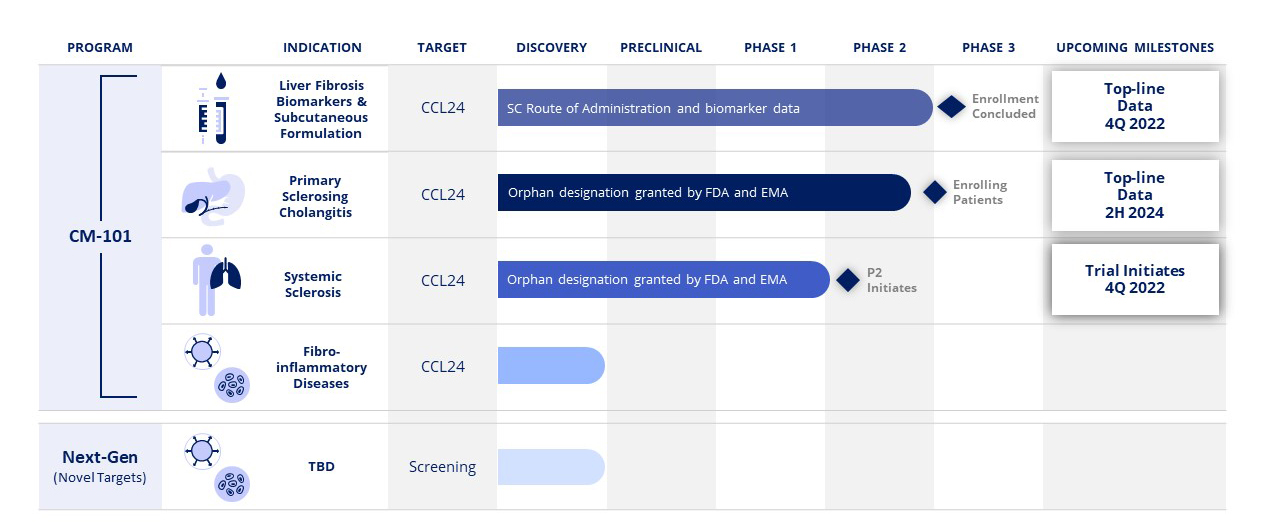Pipeline
Pipeline Overview

Pipeline by Disease
Primary Sclerosing Cholangitis
Indication
Indication
Indication
Candidate
Candidate
Candidate
Discovery
Discovery
Discovery
Preclinical
Preclinical
Preclinical
Phase 1
Phase 1
Phase 1
Phase 2
Phase 2
Phase 2
Pivotal
Pivotal
Pivotal
Primary Sclerosing Cholangitis (PSC)
Primary Sclerosing Cholangitis (PSC)
Primary Sclerosing Cholangitis (PSC)
CM-101
CM-101
CM-101
Systemic Sclerosis (SSc), also called scleroderma, is a rare, chronic autoimmune disease that is characterized by chronic inflammation, fibrosis of the skin and internal organs as well as vascular damage. SSc involves multiple internal body organs and the symptoms of the disease vary depending on the affected organs and extent of damage.
Disease Prevalence and Comorbidities
Peak age at onset of SSc is between 20 and 50 years, and it is more prevalent in women compared to men, at a 3:1 ratio. There are two forms of SSc:
- Limited cutaneous SSc, which is a slowly progressive disease with skin involvement restricted to the limbs and characterized by delayed-onset organ damage
- Diffuse cutaneous SSc, which is a more aggressive form of the disease that presents a widespread skin damage and risks rapid-onset organ damage, including effects on the kidneys, heart, lungs and gastrointestinal tract
Although SSc is considered rare, with an estimated prevalence of approximately 1 in 10,000, it has high morbidity and mortality. The prognosis varies significantly among people affected and is correlated to the extent of organ damage. Unfortunately, SSc has the highest mortality rate among the systemic rheumatic diseases with pulmonary damage being the main cause of death.
Current Treatment Options
One therapy is approved for slowing the rate of decline in pulmonary functions in patients with SSc associated with interstitial lung disease (SSc-ILD). Currently, there is no therapy approved for SSc beyond this manifestation. Current treatment is therefore directed at suppression of the immune system or management of specific disease manifestations (e.g., digital ulcers, pulmonary hypertension).
CM-101: Scientific Findings
Chemomab demonstrated the key role of CCL24 and the substantial anti-fibrotic effects of CM-101 in SSc, namely:
- In the sera and skin tissue samples of SSc patients, overexpression of CCL24 correlates with lung function deterioration
- CM-101 prevention and treatment normalizes fibrosis in experimental skin and lung animal models
- CM-101’s direct anti-fibrotic and anti-inflammatory mechanism of action (MoA) was demonstrated in multiple ex-vivo and in-vitro studies
CM-101 was found to be safe and well tolerated in human across doses and throughout multiple administrations.
Systemic Sclerosis
Indication
Indication
Indication
Candidate
Candidate
Candidate
Discovery
Discovery
Discovery
Preclinical
Preclinical
Preclinical
Phase 1
Phase 1
Phase 1
Phase 2
Phase 2
Phase 2
Pivotal
Pivotal
Pivotal
Primary Sclerosing Cholangitis (PSC)
Primary Sclerosing Cholangitis (PSC)
Primary Sclerosing Cholangitis (PSC)
CM-101
CM-101
CM-101
Systemic Sclerosis (SSc), also called scleroderma, is a rare, chronic autoimmune disease that is characterized by chronic inflammation, fibrosis of the skin and internal organs as well as vascular damage. SSc involves multiple internal body organs and the symptoms of the disease vary depending on the affected organs and extent of damage.
Disease Prevalence and Comorbidities
Peak age at onset of SSc is between 20 and 50 years, and it is more prevalent in women compared to men, at a 3:1 ratio. There are two forms of SSc:
- Limited cutaneous SSc, which is a slowly progressive disease with skin involvement restricted to the limbs and characterized by delayed-onset organ damage
- Diffuse cutaneous SSc, which is a more aggressive form of the disease that presents a widespread skin damage and risks rapid-onset organ damage, including effects on the kidneys, heart, lungs and gastrointestinal tract
Although SSc is considered rare, with an estimated prevalence of approximately 1 in 10,000, it has high morbidity and mortality. The prognosis varies significantly among people affected and is correlated to the extent of organ damage. Unfortunately, SSc has the highest mortality rate among the systemic rheumatic diseases with pulmonary damage being the main cause of death.
Current Treatment Options
One therapy is approved for slowing the rate of decline in pulmonary functions in patients with SSc associated with interstitial lung disease (SSc-ILD). Currently, there is no therapy approved for SSc beyond this manifestation. Current treatment is therefore directed at suppression of the immune system or management of specific disease manifestations (e.g., digital ulcers, pulmonary hypertension).
CM-101: Scientific Findings
Chemomab demonstrated the key role of CCL24 and the substantial anti-fibrotic effects of CM-101 in SSc, namely:
- In the sera and skin tissue samples of SSc patients, overexpression of CCL24 correlates with lung function deterioration
- CM-101 prevention and treatment normalizes fibrosis in experimental skin and lung animal models
- CM-101’s direct anti-fibrotic and anti-inflammatory mechanism of action (MoA) was demonstrated in multiple ex-vivo and in-vitro studies
CM-101 was found to be safe and well tolerated in human across doses and throughout multiple administrations.
Liver Fibrosis MoA (SC Formulation)
Indication
Indication
Indication
Candidate
Candidate
Candidate
Discovery
Discovery
Discovery
Preclinical
Preclinical
Preclinical
Phase 1
Phase 1
Phase 1
Phase 2
Phase 2
Phase 2
Pivotal
Pivotal
Pivotal
Liver Fibrosis MoA (SC Formulation)
Liver Fibrosis MoA (SC Formulation)
Liver Fibrosis MoA (SC Formulation)
CM-101
CM-101
CM-101

